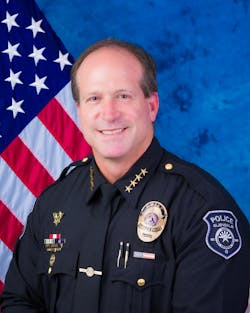Command Q&A: How Tech Has Reshaped Ariz. Police Department
Advances in technology have brought countless benefits to law enforcement command staff. New software has reduced response times and helped make patrol officers more efficient. Glendale, Arizona, Police Chief Chris Briggs recently spoke to OFFICER Magazine about how his agency has leveraged technology, along with its close relationship with Motorola Solutions.
This interview was edited for clarity and length.
This article appeared in the January/February issue of OFFICER Magazine. Click Here to subscribe to OFFICER Magazine.
How has technology shaped the GPD?
Our Real Time Crime Center has changed the way we police. It’s made us more efficient and made our officers safer because they're getting real time situational awareness from a trusted source. In addition to that, we've rolled out a new RMS and CAD system, which has given us more data. More data allows you to look at where crime is to know how you can deploy your resources. That makes a difference in traditional policing. We now have live 911 transcription in our RTCC through Motorola’s VESTA.
Our operators in the call center receive a transcript and we have certain words that are highlighted during a call. It might be “gun,” “shooting” or “injury.” They watch the call as it comes in and look for camera resources to put on that incident before the call makes it to dispatch, and before it is dispatched to officers.
How has the buy-in been by officers and staff?
We launched our Real Time Crime Center in 2019 and we know what happened in 2020 with COVID-19 and the Defund the Police movement across the country. There were a lot of recruitment and retention issues that all law enforcement agencies dealt with, including us. We were a very senior agency at that point, so we had a lot of people naturally leaving. Then you had the issue of recruitment and getting people in the door. What was amazing about the effect of the Real Time Crime Center is that when I would go to briefings, the officers would say, “When are you putting more people in there so we can be 24/7?” because we only had three operators in there at the time. Every officer knows that when you create a new position that vacancy typically comes from the patrol division, which then has to be backfilled. Despite all of the specialty positions that we needed to put a hold on filling, they wanted more people in Real Time Crime because it had that much of an impact on their success and safety on their calls for service.
How has the relationship with Motorola Solutions grown?
I've always known Motorola because I've had a Motorola radio since 1992. We had the radios and eventually ended up using CommandCentral Aware, their Real Time Crime Center software. And then we went to their CAD and RMS solution, VESTA. This was not intentional, it was just normal procurement. But as we dove in and built a relationship with Motorola, we found that they listened and leaned into it with us. It’s the one vendor—and it's clear by the number of Motorola products we have—in all my 32 years in law enforcement that I believe is just as invested in our success as we are.
What advice would you give other departments?
I highly encourage anybody who's looking at technology to look to somebody else who has the same or similar technology. Visit them and see how they are using it, see what the applications are. What did they learn from it while building it? Where did they fail? We all make mistakes as we get into things. What were those pain points? And then, is this something that works for your agency? If it does, why not work to build from a foundation that already exists? You don’t have to reinvent the wheel.
Listen to the full interview at officer.com/55261401
About the Author
Paul Peluso
Editor
Paul Peluso is the Managing Editor of OFFICER Magazine and has been with the Officer Media Group since 2006. He began as an Associate Editor, writing and editing content for Officer.com. Previously, Paul worked as a reporter for several newspapers in the suburbs of Baltimore, MD.


